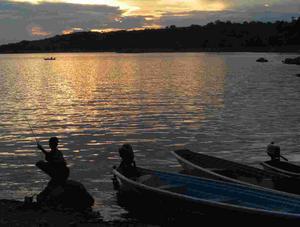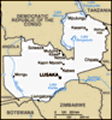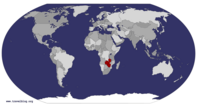Advertisement

 A Zambian Lady Fishing on Lake Kariba
A Zambian Lady Fishing on Lake Kariba
I don't have any other pictures of Livingstone, but Lake Kariba is connected to the Zambezi River which runs just south of Livingstone...close enough?So after my two weeks of training in Mazabuka I was off to the tourist capital of Zambia, Livingstone. I have been there for the past two weeks again learning about opeating a development field office after which I've come back to the capital, Lusaka, for a final debrief. Finally, tomorrow I will be off to my home, the small town where I will be living, working, and reporting to you for the majority of my time here, Choma.
Livingstone is the tourist capital of Zambia for a reason. It is home to one of the most spectacular sights in the entire world, Victoria Falls. Not to be outdone, it is also home to a whole range of wildlife viewing opportunities and extreme sports such as white water rafting down the beautiful Zambezi River. Now, I have mentioned how I don’t want to romanticize too much all the wildlife here in Zambia because I feel that there is too much emphasis on it and not the people here. However, for the few of you out there who open up my blog singing “Hakunah Matatah” with images of me darting through African

 Vic Falls
Vic Falls
Because I lost all my other photos, I had to borrow this one of someone on the internet. Thanks www.geographicguide.comjungle carrying a machete and running away from wild lions, I’ve maybe got something half as interesting written below. You can read about my experiences with the likes of elephants, hippopotamuses, crocodiles and giraffes by clicking on the romantic Zambia link below (sorry about the lack of good pics, they are available for viewing for anybody who can recover my stolen laptop).
Romantic Zambia: Girrafes and Hippos and Waterfalls Oh My! So, believe it or not, I actually did some work while I was in Livingstone. What an IDE field office actually does is actually becoming more and more evident to me. My NGO, IDE, focuses on using a market approach to development. This means that instead of giving things away for charity, we focus on developing ways of creating a private sector that focuses on helping the poor as opposed to the rich. The goal of this approach is to make development more self-sustaining, relying less and less outside support in the future. The main question that usually comes up then is how a private sector, who’s main focus is to earn profit, is going to care about and keep prices low enough to benefit those who don’t have very much money. The answer to

 Beautiful Scenery
Beautiful Scenery
This photo is of the bridge joining Zambia and Zimbabwe. It was taken by my friend Mikethis question is complex; however in short, although poor people don’t have much money, there is still a huge potential market for them because there are so many of them. The difficult part is that helping these markets takes a lot of time, a lot of initial investment and a really good idea that has been proven to work. The treadle pumps and drip irrigation systems that IDE promotes have been proven to be a damn good idea, as evident by the 1.2 million poor people around the world who have already adopted them. However, each place that they have been promoted has had its very unique circumstances based on the political, economical, social and cultural factors of that area. It takes a lot of time and initial investment to figure out these different circumstances in every new place they are implemented, many times with many failures. In Bangladesh and India, where the technology was first adopted, it has taken over 20 years and millions of dollars of initial investment before systems have become well adopted. But now they estimate that all the farmers currently using a treadle pump have a combined earnings over $100 million dollars a year, which averages to around $100 more per farmer per year, which is most of the time at least double what they used to earn.
The technology in Zambia however has been around for much less time so it is taking some time to understand the specific regional country circumstances for the systems to catch hold. That is going to be part of my job here. It is also difficult because of the huge difficulties in gaining the initial investment from outside donors, despite the historically huge return on investment in terms of poverty reduction.
Another challenge that I’m going to be facing in my work is from the current drought situation in Zambia. In my last blog, I talked about how despite being the rainy season, it has only rained once since I arrived. It has now been 3 more weeks and during that time it again has only really rained once. It is now almost harvest time for all the crops around the country, but according to the government reports (which do tend to be exaggerated in order to alarm the country), this years yield is only going to provide 30%!o(MISSING)f the food needed to feed all of Zambia. This very unfortunately means once again, that come a few months time when this food runs out, food relief will be needed in order to prevent what is termed by the newspapers as “massive starvation”. I must try to remind everyone though that even though this sounds like a massive emergency through my outsider eyes, food shortages have become so common here that it just seems like another day for most Zambians and they would probably laugh at my depiction of the situation.
So right now I am dealing with drought causing problems for the farmers in my area not being able to have access of water to operate their pumps due to the low amounts of rain water in their wells and rivers. Then I also have to deal with farmers not having enough food to provide them with enough energy to operate the pumps. But there is also one other very unexpected challenge that I am going to be facing that I never imagined I would have to be dealing with before I came. This challenge relates to the cultural attitudes of farmers in my area related to receiving free food aid.
Over the past decade and a half, Zambia has been hit especially hard in many of the years by heavy droughts. These conditions have caused major crop failures leading to certain parts of the country to be on the brink of starvation. This cry of starvation has been heard by many outside countries and in response to it, a intricate network of food relief infrastructure has been set up to help feed many of the hungry bellies. In the short-term, these systems do a great job of dealing with the emergency situation in front of them, but as my personal anecdote of dealing with a farmers meeting hopefully illustrates, there are also longer-term side effects created by food relief, ones that have broad reaching consequences that few tend to think about when dealing with the starvation crisis at hand.
Development Point: Sleeping With the Enemy After Livingstone, even though I really appreciated all the great training I had been given, I was getting very anxious to finally settle down in Choma and get to work. I had been living a very transient lifestyle that was very dependent on other peoples schedules and priorities and I was craving some control and independence in my own life. I had so many questions in my mind like what life in Choma was going to be like? Where will I live? What food will I eat? How many wives am I going marry? (just kidding mom).
So now I'm in Lusaka trying to gather all the last minute information about starting up and operating a field office before being released all alone into the open wilderness of rural Zambia. Starting up an office includes: developing a local treadle pump manufacturing and retailing sector, marketing and promoting the pumps, providing ongoing support to farmers with pumps, trying to find markets for these farmers to sell their crops on, and finally overseeing that the overall process of this linkage train actually helps reduce the vulnerability of these farmers and therefore reduces poverty in Zambia……phew……no problem….. hey? (to be read in the same tone as a teenage child with a manic bed wetting problem heading off to his first sleepover party).
Of course it’s not going to be as remote or alone as my mind tends to romanticize right now. I am going to partnering with many other people working with many other government and non-government organizations already operating in Choma. I am also going to have constant feedback and support from my head office throughout. But as for now, it still seems like quite a daunting task. My bus leaves tomorrow morning at 8:00am and it is hard for me to keep still in any one place for very long. My imagination is a flurry of hopes, dreams, fears and possibilities and I probably won’t sleep tonight. Tomorrow I’m going to finally start my real life in Zambia and although I think most of its excitement, I must admit, there’s a part of me that’s really damn scared.
Advertisement
Tot: 0.134s; Tpl: 0.011s; cc: 10; qc: 63; dbt: 0.0768s; 1; m:domysql w:travelblog (10.17.0.13); sld: 1;
; mem: 1.2mb








